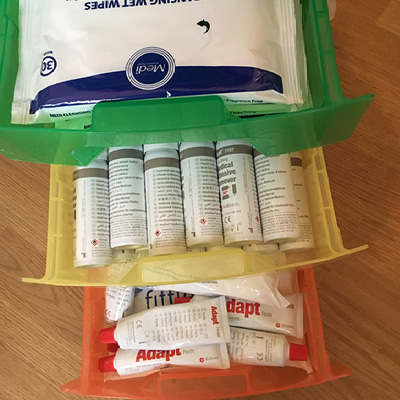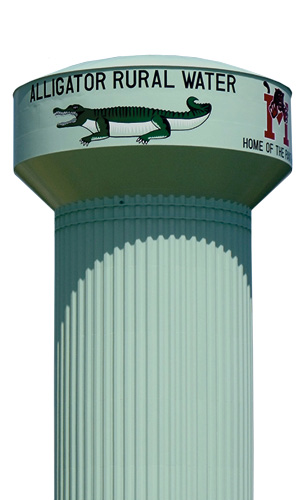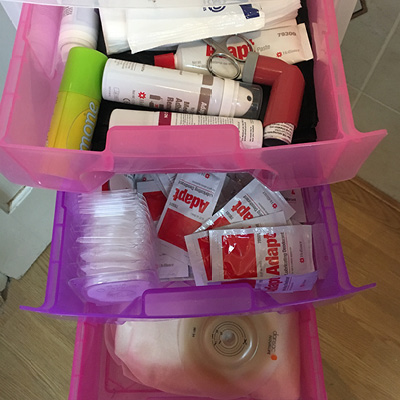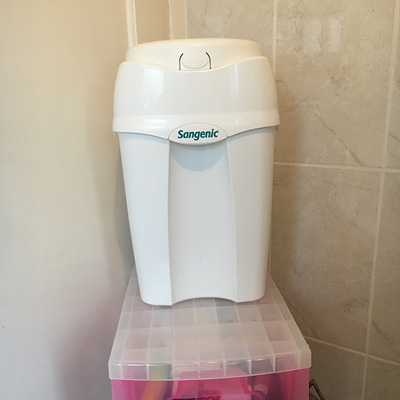Not long after I got home from surgery, I felt like I was drowning in a mountain of appliances and accessories. The standard-issue blue supply bag I had been given while recuperating in hospital was easy; the stoma nurses would simply top it up with supplies every couple of days, and it didn’t take up a lot of space. But after discharge, it didn’t take many orders before it became glaringly obvious that I needed a safer, more hygienic way to store supplies, and one that didn’t take up so much room.
‘I felt like I was drowning in a mountain of appliances and accessories ’
No one had spoken to me in any depth about storage, but I pretty quickly found it to be an issue. I was soon swamped in boxes and bags, both unopened and discarded, which were beginning to creep up the bathroom walls like ivy on an abandoned building.

Wheels make the tower easy to move to and from the bathroom
The solution
I’d just about had enough, when I was walking around a local arts and crafts store and had my eureka moment. I walked out with a brand new wheeled plastic storage tower and a plan for a concise storage system, and I haven’t looked back since.
Each time a box of supplies arrives (monthly for me), I recommend this routine. This can take upwards of an hour, so you may want, after checking everything’s there, to put your new box aside until you have some free time. It’s certainly worth sitting comfortably where there is plenty of space (I prefer my bedroom), grabbing a cup of coffee and sticking on a good movie before getting to work.

Having things in one place helps you know if you are running low on certain supplies
 Set up your station
Set up your station
• Wheel the tower in front of you, with enough of a gap for easy access to the drawers
• Place the package of stoma supplies and a pair of scissors on your right
• Get a recycling bag and a big black bin bag, shake them out and put them on the floor to your left
Prepare your supplies
• Open the package
• Double-check everything you ordered is there
• Arrange the supplies into piles by type
• Unbox/unbag and put away the items, one at a time
• Remove and bin item’s packaging
• Check item for damage
• Place item in allotted drawer
Getting it done
Try to think of it like shucking oysters; you’re going to need to find your rhythm. By now, I have become a ninja master in the school of unbox/unbag, dispose and store.
‘you’re going to need to find your rhythm’
Stoma rings, if stored unwrapped, will stick together and become unusable, so leave them in their individual plastic cases. If, like me, you cut your own stoma bags, you might want to leave these till last (I find cutting my own bags gives me the control I need, as my stoma has been changing shape as I’ve lost weight). If your bags have drainable ends, closing them at this stage makes them more compact and saves time when changing bags later. I place batches of 15 bags on top of the tower before I take them down one by one, cutting them to size, closing them and placing them head-to-tail in the drawer, one on top of the other so they lie flat.

Coloured drawers can make it easier to remember which is which
Finishing up
Then I just have to take out the bin bags and roll the tower back into the bathroom. This is the ideal time to clean and disinfect the stoma-tower. I also use this time to empty and clean the nappy bin I keep on top of the tower for the disposal of used stoma bags during a change.
The time it takes to restock the tower is saved many times over during bag changes. Most importantly, being organised with your storage helps regain a feeling of bodily control. My stoma tower is an ongoing project, and I keep trying new things, some of which work, and others don’t. For my dream tower, I may need to commission a carpenter to build exactly what I want. As I begin to view my stoma supplies as a kind of treasure—a most unusual bounty—it is only fitting to have an appropriate treasure chest to secrete them in.

A nappy bin is the ideal hygeinic solution for the disposal of used stoma bags
 Natalie Toper is a qualified counsellor, specialising in working with cancer patients and survivors; she lives in Greater London
Natalie Toper is a qualified counsellor, specialising in working with cancer patients and survivors; she lives in Greater London
Website
The contents of this page are property of MA Healthcare and should not be reused without permission

